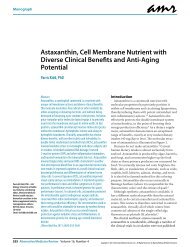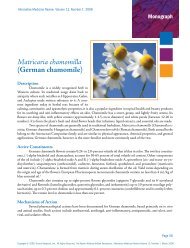Harpagophytum procumbens - Alternative Medicine Review
Harpagophytum procumbens - Alternative Medicine Review
Harpagophytum procumbens - Alternative Medicine Review
Create successful ePaper yourself
Turn your PDF publications into a flip-book with our unique Google optimized e-Paper software.
Monograph<br />
Mechanisms of Action<br />
Anti-inflammatory<br />
A dried aqueous extract of devil’s claw has been<br />
shown to exert a significant dose-dependent analgesic<br />
and anti-inflammatory effect in rats at 5 and 10 mg/<br />
kg. However, carrageenan-induced paw edema was not<br />
affected by the isolated harpagoside constituent, suggesting<br />
harpagoside may not have an anti-inflammatory<br />
effect, at least in the doses used in this animal model of<br />
inflammation. This suggests that other devil’s claw constituents<br />
may be responsible for the anti-inflammatory<br />
effect. 10<br />
An in vitro study using two rat cell lines found<br />
harpagoside inhibited lipopolysaccharide-induced inducible<br />
nitric oxide (iNOS) and cyclooxygenase-2<br />
(COX-2) expression via nuclear factor kappaB (NFκB)<br />
suppression, thereby inhibiting inflammation. 11<br />
Another similar in vitro study compared two devil’s claw<br />
root extracts for their effect on iNOS expression in rat<br />
mesangial cells. One extract contained naturally present<br />
root constituents and 8.9-percent harpagoside, and<br />
the second extract contained naturally present root extracts<br />
and 27-percent harpagoside. A significant (80%)<br />
suppression of nitrite formation was observed for both<br />
extracts and was attributed to reduced iNOS promoter<br />
activity and suppression of NF-κB translocation. Interestingly,<br />
a harpagoside-free extract also inhibited iNOS<br />
expression to a significant degree, indicating extract<br />
constituents other than harpagoside are in part responsible<br />
for the anti-inflammatory effect. 12<br />
Analgesic<br />
Harpagoside appears to exert a peripheral<br />
analgesic effect. Human research has demonstrated<br />
decreased pain in knee and hip osteoarthritis and nonspecific<br />
low-back pain after ingestion of devil’s claw extracts<br />
containing harpagoside. 13,14 Although the mechanism<br />
behind this effect has not yet been determined, it<br />
is thought to be closely connected to its anti-inflammatory<br />
properties.<br />
Antioxidant<br />
Animal research has demonstrated a significant<br />
antioxidant effect for devil’s claw extract when<br />
administered intra-peritoneally to rats. Dose-dependent<br />
increases in superoxide dismutase, catalase, and<br />
Page 249<br />
<strong>Alternative</strong> <strong>Medicine</strong> <strong>Review</strong> Volume 13, Number 3 2008<br />
glutathione peroxidase were observed in rat brain tissue<br />
and a reduction in lipid peroxidation was also noted.<br />
The antioxidant properties may be partially responsible<br />
for the anti-inflammatory effect of devil’s claw extracts. 15<br />
The flavonoids (proven scavengers of free radicals) 16<br />
and plant phenols (hydrogen donors and oxygen radical<br />
neutralizers) 17 present in devil’s claw extracts may be<br />
the constituents responsible for the observed antioxidant<br />
activity.<br />
Digestive Aid<br />
The “bitter” action of devil’s claw provided by<br />
the iridoid glycosides increases gastric acid production<br />
and stimulates digestion. 18<br />
Chondroprotective<br />
<strong>Harpagophytum</strong> is chondroprotective, possibly<br />
due to inhibition of inflammatory mediators, including<br />
COX-2, leukotrienes, nitric oxide, tumor necrosis<br />
factor-alpha (TNF-α), and interleukin-1β. In addition,<br />
matrix metalloproteinases and elastase that play key<br />
roles in cartilage degradation are inhibited. 11,19<br />
Clinical Indications<br />
Numerous trials have been conducted using<br />
devil’s claw extracts of various types for osteoarthritis,<br />
rheumatism, or low-back pain. Unfortunately, the results<br />
of many of the studies are of questionable value because<br />
of methodological flaws. Early uncontrolled trials did<br />
provide valuable information on appropriate dosing and<br />
adverse effects, but most of the trials comparing devil’s<br />
claw with other medications for arthritis and back pain<br />
were potentially biased due to lack of blinding and randomization.<br />
Several randomized, placebo-controlled<br />
studies (RCTs) were also flawed due to poor or absent<br />
baseline data, while others lacked transparency of data.<br />
In addition, a few of the studies used special extracts<br />
of devil’s claw not available clinically, so results are of<br />
limited clinical value. Studies yielding the best results<br />
utilized devil’s claw extracts containing 50-100 mg harpagoside<br />
daily. 20<br />
Copyright © 2008 Thorne Research, Inc. All Rights Reserved. No Reprint Without Written Permission.







